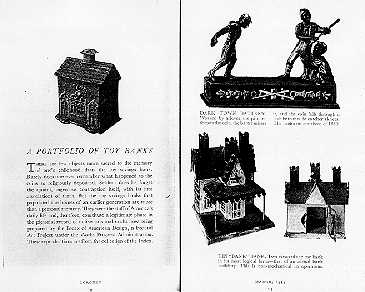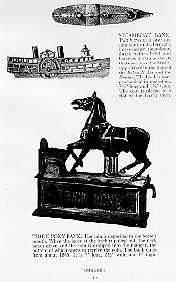CORONET — March, 1939
A PORTFOLIO OF TOY BANKS


T
HERE are few objects more sacred to the memory of one’s childhood than the toy savings bank. Rarely does one ever remember what happened to the coins so religiously deposited. Seldom does he forget the quaint, ingenious contraption itself, with its first associations of thrift. But the toy savings banks that populated the homes of an earlier generation are more than a personal memory. They were the stuff of America’s daily life and, therefore, constitute a legitimate phase in the pictorial record of native arts and crafts now being prepared by the Index of American Design, a Federal Art Project under the Works under the Works Progress Administration. These reproductions are from the collection of the Index.Captions under photos:
 DARK TOWN BATTERY.
Worked by a lever, the pitcher throws the coin, the batter misses it, and the coin falls
through a hole between the catcher’s knees. The uniforms are those of 1880.
DARK TOWN BATTERY.
Worked by a lever, the pitcher throws the coin, the batter misses it, and the coin falls
through a hole between the catcher’s knees. The uniforms are those of 1880.
Tin "BANK" BANK. Two views of the toy bank in its most logical form — that of an actual bank building. This is non-mechanical in operation.
SANTA CLAUS BANK. Dated 1889, this bank has its coin slot in the chimney. Santa is 5-1/4" high.
BULL FROG BANK. Dated 1872, this bank is mechanically operated. The eyes can be rolled and the lower jaw opened by pressing the right front foot, which is hinged to the leg and is elongated to form a lever. The coin may then be deposited through the frog’s mouth into the cylindrical base of the bank. The base is 4-1/2" in diameter.
HORSE HEAD BANK. As shown in the right-hand view of this bank, dated before 1900, the horse’s mouth opens from the snout to the back of the head, where it swings on a hinge. The coin is deposited in the slot inside the mouth. The bank is not mechanical; it is necessary to lift the head to locate the slot. Height, 5-3/8" .
TAMMANY BANK. This figure deposits a coin in his pocket.
"HUMPTY DUMPTY" BANK. This cast-iron bank is dated 1882. It is 7-5/8" high.
ELEPHANT BANK, shown in four views. The coin is placed in a slot at the end of the trunk. When the tail is pulled the trunk flies up, depositing the coin in the howdah. Height, 5-1/2" , length, 8-3/4" .
STEAMBOAT BANK. Two views of a cast-iron coin bank in the form of a side-wheeler steamboat, dated before 1900 and based on the famous boats that once plied the Mississippi River in the days of the Robert E. Lee and the Natchez. The bank is non-mechanical in operation, 7-5/8" long and 1-3/8" wide. The coin is placed in a slot at the boat’s stern.
TRICK PONY BANK. The coin is deposited in the horse’s mouth. When the lever at the back is pulled out, the neck bends down and the coin is dropped into the manger, the bottom of which opens to receive the coin. The bank dates from about 1885. It is 7" long, 2-1/2" wide and 8" high.
